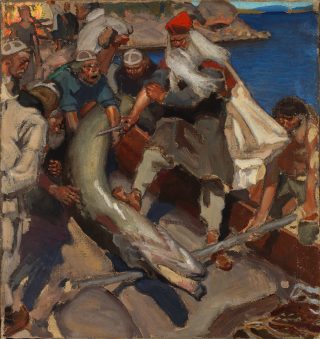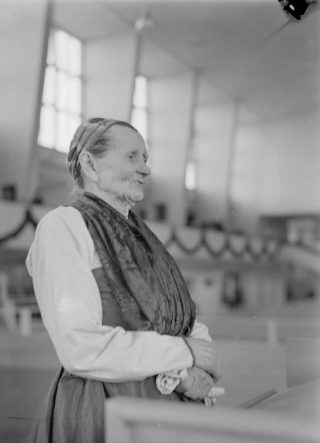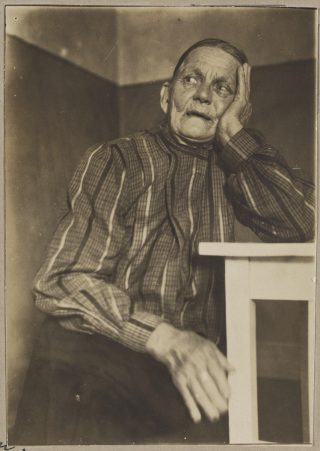KANTERVO album release 5 Nov 2023
News
November 04, 2023
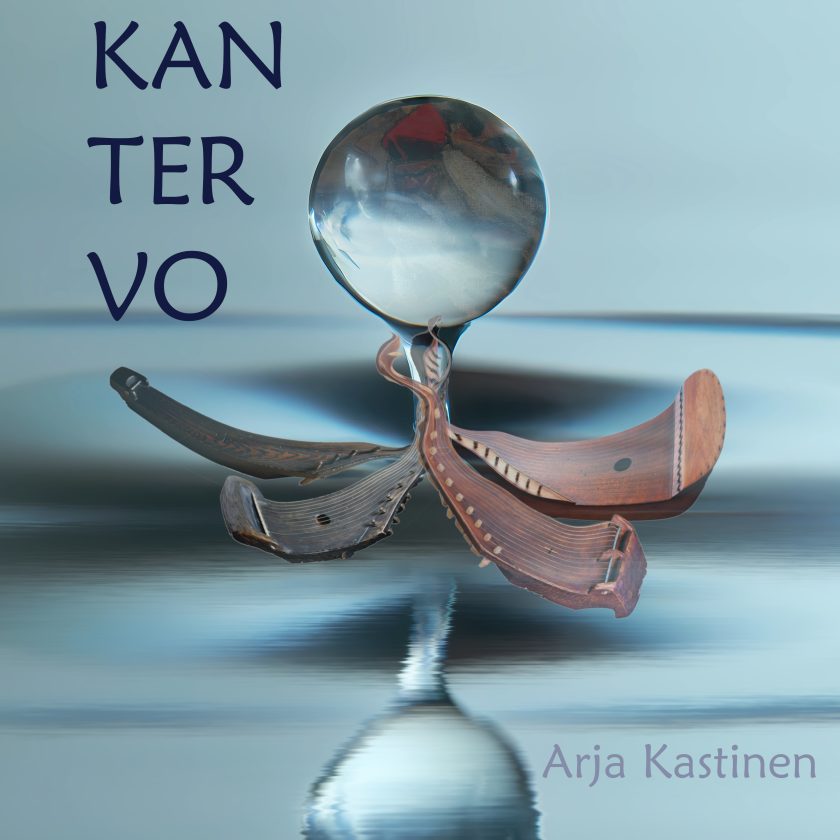
KANTERVO (TEMPS 08), digital album release 5 November 2023
Recording: Arja Kastinen
Mastering: Taito Hoffrén
Cover art: Tuomas Ylönen
EAN 6430032710006
ISRC FI9TE2300001–00010
The album is released as part of the research project Kantele of the Runosong Culture and the Dialogue of Creativity.
The album contains new music on the copies/new versions of museum kanteles. The music is drawn against the horizon that connects the past and the future of the kantele improvisation aesthetics of the Runosong culture. The album will be available on all digital services from 5 November 2023. Buy from Bandcamp.
Tracks:
- Vesikivelle (13- and 5-string kanteles with bronze strings)_6:19_comp. by Arja Kastinen
- Poropetra (a 14-string kantele with steel strings and a 5-string kantele with bronze strings)_3:08_comp. by Arja Kastinen
- Jouten laulo (a 12-string kantele with brass strings and a 15-string kantele with steel strings)_3:15_comp. by Arja Kastinen
- Laivaretki (a 15-string kantele)_4:29_comp. by Arja Kastinen
- Heinän päillä (a 15-string kantele)_3:53_comp. by Arja Kastinen
- Kullervo, feat. Ogoi Määränen 1936, SKSÄ 2011:54 (a 5-string and a 13-kantelewith bronze strings)_3:36_comp. by Arja Kastinen & Ogoi Määränen & Trad.
- Poigu Kalervo (a 5-strin kantele with bronze strings)_5:18_comp. Trad. & Arja Kastinen
- Joga puu, feat. Matrona Kyyrönen SKS KRA FON 1915:66d (a 13- and a 5-string kantele with bronze strings & a 5-kantele with viscose strings)_3:52_comp. by Matrona Kyyrönen & Arja Kastinen
- Kantervo kalan evästä, feat. Oskari Lehtonen (a 12-string kantele with brass strings & a 15-string kantele with steel strings & percussions)_9:13_comp. by Arja Kastinen & Oskari Lehtonen
- Soitimbo (a 14-string kantele with steel strings and a 13-string kantele with bronze strings)_6:29_comp. by Arja Kastinen
The music is based on improvisation, an ancient plucking technique and modified tuning. Some (possibly) newer playing techniques are also used, and several pieces combine different kanteles. The instruments are new versions/copies of some interesting examples in museums.
More on Music, Instruments and Tracks
Kantele music and improvisation were an important part of Finnic runosong culture for centuries and continued as an active tradition in the remote areas of Karelia until the beginning of the 20th century. The cultural significance of both the instrument and the music played on it is evidenced, for example, by the descriptions of kantele playing recorded in the regions of Karelia and the more than 400 runosongs related to the mythical birth and playing of the kantele published in the collection SKVR, (Ancient Poems of the Finnish People).
Several of the names of the tracks on the album are taken from songs published in the SKVR. The runosongs from Viena Karelia about the mythical birth and playing of the kantele gave the album its title KANTERVO (a poetic synonym for the word kantele). For example, Martiska Karjalaińi sang to Elias Lönnrot in Vuokkiniemi in 1834:
– – –
Soiton tuosta seppo saisi,
Saisi soiton sorsan luisen,
Kantervon kalan eväsen – – – (SKVR I1, 647)
The album cover (made by Tuomas Ylönen) illustrates the songs about the mythical birth of the kantele, the element of water, which is often part of the songs, and the border between the worlds. Inside the water bubble looms the image of Väinämöinen, who created a kantele out of fish parts in many songs. The image is taken from Akseli Gallen-Kallela‘s painting Suuri hauki (The Giant Pike, 1904, Finnish National Gallery), which also depicts the phenomenon of late 19th-century Karelianism.
I tune the kanteles to different pitches and scales, depending on what the music in progress requires or where it takes the tuning. The scales are therefore not uniformly tuned, but the tuning often tries to bring the thirds closer to the natural ones. This means that some of the fifths may be pure, but others have been shortened so that the thirds are the desired size. Also, especially with the 12-string kantele with brass strings, I have often started from an A4 that is considerably lower than the current standard (e.g. 438 or 436 Hz), but on this album I ended up keeping the A4 at 440 Hz for all the instruments.
Copies of museum kanteles can be a bit difficult to tune, both in terms of tuning technique and tuning stability. In addition, the fluctuations inherent in the sound characteristics mean that it is not even possible to achieve an exact tone level comparable to that of a digital instrument, for example. But for me, all this just adds to the fascination of the instrument and the interesting sound it produces. The sound is alive, constantly changing over time and with the personality of each instrument. For me, kanteles tell stories, as Arhippa Perttunen and Simana Sissonen have said: Kielin kantelo pakasi (SKVR VII1, 625; SKVR I1, 615) (–It could be translated as “kantele spoke in tongues”, with the comment that the Finnish word “kieli” can mean tongue, language or a string of an instrument.)
1. Vesikivelle.
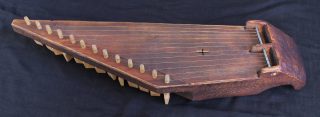
A copy of the 13-string kantele bought from Ilomantsi for the National Museum in 1877 (K1855:12). The copy was made by Jouni Kurki.
The song is played on a 13-string and a 5-string bronze-stringed kanteles (copies of the National Museum’s kanteles K1855:12 and K1855:37). The music is improvised and the published version is an edited combination of several improvised recordings. The name of the song comes from a runosong probably sung by Boris Vanninen in Impilahti in 1847 (– it describes how the demon’s dame comes to sit on a stone in the water [= vesikivelle] to comb her hair with a golden comb and listen to the kantele music):
– – –
Istuhin vesi kivelle
Hiien eukko, harva hammas,
Hapsehia harjaeli,
Kulta su’alla sukivi – – – (SKVR VII1, 545)

Built by Rauno Nieminen, a copy of the 5-string kantele (K1855:37) bought for the National Museum from the daughter of Ontrei Malinen in Viena Karelia in 1877. The year 1833 is engraved on the side of the instrument.
The two lowest strings of the 13-string kantele are tuned to the same pitch, which increases their resonance and changes the timbre of the instrument. One of my efforts in improvisations like this is to try to achieve the freedom of improvisation of a 19th century Karelian illiterate kantele player, letting the subconscious define the movements of the music. Although the hands are separated on different instruments, they still play alternately in a way similar to the old plucking technique.
The scale of the 5-string kantele:

The scale of the 13-string kantele:

2. Poropetra.
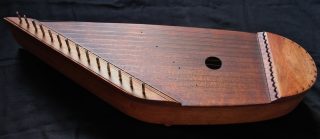
A 14-string copy of the kantele KF2148, built by Rauno Nieminen and bought for the National Museum in Korpiselkä in 1916.
In Poropetra, I combine the 5-string kantele used in the previous tune with a 14-string round end steel-stringed kantele from Korpiselkä (copy of the National Museum’s kantele KF2148), which represents the change in musical culture. The background sound is the sound of Nötö’s ringing stone, recorded 9 years ago with my friend Tuula Olkanen.
The word Poropetra (a poetic combination of poro = reindeer and peura = deer) can be found in several runosongs from Viena and Border Karelia, but it is linked to the kantele runosongs by Elias Lönnrot‘s note in Jyskyjärvi in 1835. Miihkalińe Simana sang:
– – –
Niin se juoksi Hiitten hirvi,
Poropetra poimetteli – – – (SKVR I1, 1)
The scale of the 14-string kantele:

The scale of the 5-string kantele:

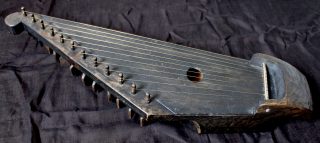
Built by Rauno Nieminen, a copy of the hollow 12-string kantele with brass strings purchased from Iivana Shemeikka in 1906 for the Perniö Museum.
3. Jouten laulo.
The tune is played on a combination of a 12-string kantele with brass strings and a newer model of 15-string kantele. The brass-stringed kantele is a copy of a kantele which was bought for the Perniö Museum in 1906 from runosinger Iivana Shemeikka. The copy was made by Rauno Nieminen.
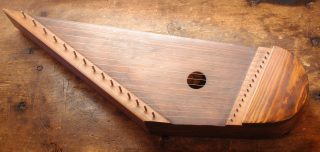
A modified copy of the Korpiselkä kantele KF2148 bought for the National Museum in 1916, built by Keijo Säteri.
The 15-string kantele is a modified copy of the Korpiselkä kantele in the previous song. It was made by Keijo Säteri in 1994. I played my first solo album with this kantele in 1995 and it has probably accompanied me on my musical journeys more than any other instrument. The song was practically composed on the computer by editing several separate improvisation recordings..
The name of the tune comes from the same runosong as above, i.e. from a song sung by Miihkalińe Simana from Jyskyjärvi in 1835 (–It describes how Väinämöinen played the kantele and sang idly = jouten laulo]:
– – –
Kuink’ on soitti Väinämöinen,
Kuink’ on jouten laulo. – – – (SKVR I1, 1)
The scale of the 12-string kantele:

The scale of the 15-string kantele:

4. Laivaretki.
This tune is played on the 15-string kantele introduced in the previous song. The pitch of the instrument has been lowered by a semitone compared to the previous tune. Oskar Relander wrote in 1903: “..among kantele players, you sometimes meet such people who play ‘their own power’, that’s what’s on their mind at any given time. Such a player plays for all sorts of life events, plays farewells for different people in different ways, describes the passage of a ship at sea, accompanies the fairy tales he tells with his playing, describes his state of mind.” This tune therefore refers not only to the boat trip often associated with the kantele runosongs, but also to the improvisation mentioned by Relander. [laivaretki = boat trip]
The scale of the 15-string kantele:

5. Heinän päillä.
Like the two previous tunes, this one is also played on the 15-string kantele. The pitch has again been lowered by half a tone compared to the previous one. As you can hear, echoes have been added to the sound. The background soundscape is a stretched sound from the same recording. The name of the song is taken from a runosong about the origin of the kantele sung by Oudot’i (= Outi) Vasiljovna in Suojärvi in 1884 (–These phrases describe how the sun comes to listen to Väinämöinen’s kantele playing and lies down on the tips of the hay [= heinän päillä]). :
– – –
Päivyni heitty heinän päillä:
Vänämöin soitantoo kuunnellah. – – – (SKVR VII1, 112a)
The scale of the 15-string kantele:

6. Kullervo, feat. Ogoi Määränen (1936, SKSÄ 2011:54).
This tune uses the 5- and 13-string kanteles introduced in track 1. The song begins with an improvised 5-string solo, with the kantele tuned in A minor:

Ogoi Määränen‘s extremely interesting song with varying metres is a recording by Fritz Bose from 1936 in the archives of the Finnish Literature Society (SKSÄ 2011:54). Ogoi sings about Kullervo, the son of Kalervo, who went off to war with a sense of joy. He played his horn and the sounds echoed off from the landscape around him. During the journey, he receives three death notices. (This is a number that often appears in runosongs.) The first notice is about his father who is dying, and the second is about his mother. He reacts to both in the same way, pretty much saying that he doesn’t care, that he will get better parents anywhere. The third message is about his bride dying. Now the meter of the songs changes to 5/4 as Kullervo laments his harsh fate.
During Ogoi’s song I play a lament melody from Suistamo (Runosävelmiä II, 20_1905) on the 13-string and 5-string kanteles.
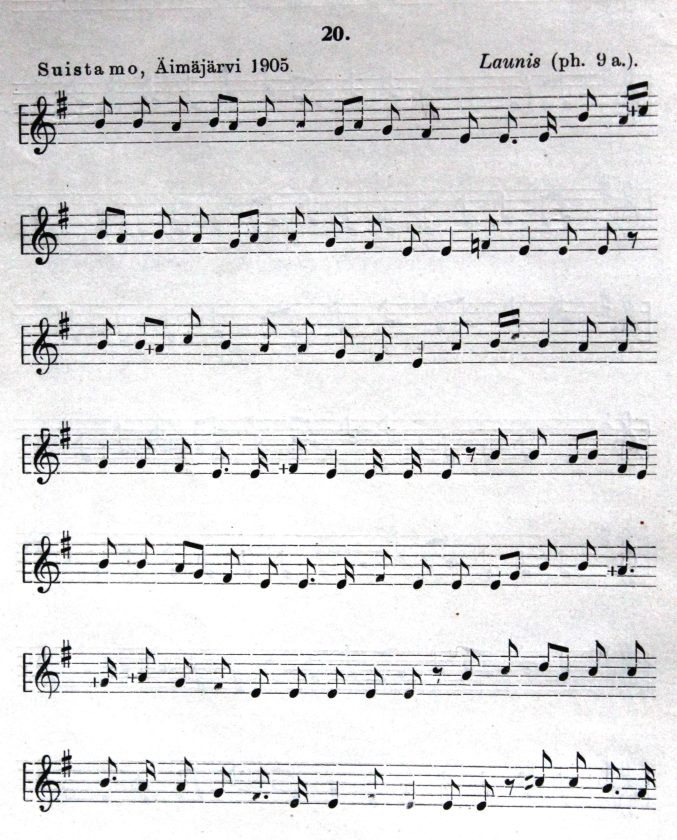
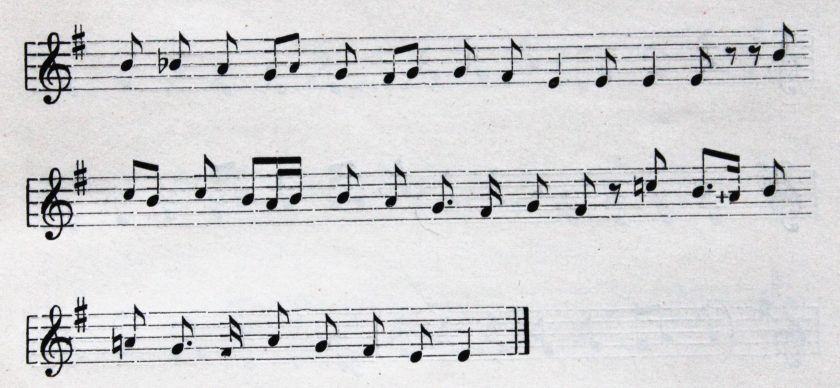
Runosävelmiä II, Karjalan runosävelmät nro 20, s. 20
The 5-string kantele is tuned to the micro-intervals that differ from the 13-string kantele tuning, as marked on the sheet music. Although I have used the modified tuning in all the songs, I have not marked it on the scales for the other songs, because the pitch deviation also varies depending on which point of the string it is plucked from and at what volume it is played, and the deviations are usually quite small. For this tune, however, I have marked the modified pitches on the scale, because tuning intervals of different sizes for two different kanteles was an essential part of the experiment: unlike a singer, a hollow kantele player can hardly influence the pitches of the instrument while playing. That is, I was trying to see if I could reasonably play the micro-intervals marked on the sheet music if I use two kanteles.
The scale of the 13-string kantele in the lament:

The scale of the 5-string kantele in the lament:

7. Poigu Kalervo.
Played on the 5-string kantele introduced above. An improvisation based on a lament recorded in Suistamo in 1905 (Runosävelmiä II, 18). This is a continuation of the previous song and the name comes from the lyrics by Ogoi Määränen: Kullervo, poigu Kalervo (= Kullervo, the son of Kalervo).
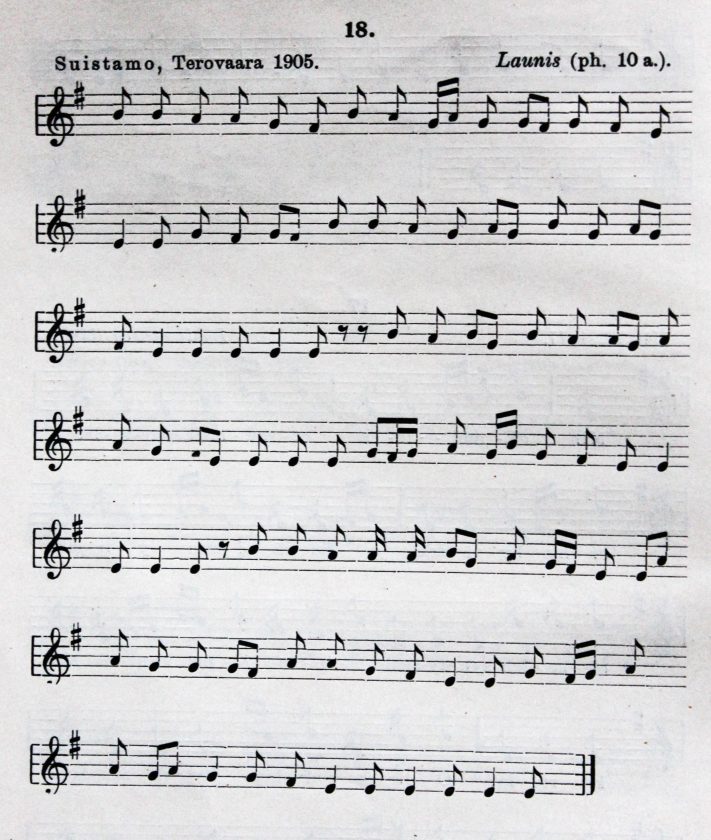
Runosävelmiä II, Karjalan runosävelmät nro 18, s. 18.
The scale of the 5-string kantele:

8. Joga puu, feat. Matrona Kyyrönen (SKS KRA FON 1915:66d).

Built by Rauno Nieminen, a copy of the kantele built by H. Roponen from North Ostrobothnia in 1893 (tay229).
The melody is played on the 13-string kantele introduced at the beginning (a copy of kantele K1855:12) and two 5-string kanteles. One of the 5-string kanteles is Ontrei Malinen’s kantele introduced earlier. The other is also a copy made by Rauno Nieminen, but the origin of this kantele is in Northern Ostrobothnia. The kantele belongs to the collections of the Folklore Archive of the University of Tampere (tay229) and is housed in the Kaustinen Museum of Finnish Folk Instruments. The original kantele was made by H. Roponen and was acquired in 1893. My instrument is strung with viscose strings, which I got from Juhana Nyrhinen. The sound is similar to horsehair strings, but they hold the tuning better in concert use.
At the beginning of the song, I play a melody on the 13-string kantele that Matrona Kyyrönen will sing after. I have added ornaments and accompanying sounds to the melody. The melody is in the range of the first five notes of the Phrygian scale, and from the very beginning I drew attention to its interesting notation (Runosävelmiä II, 158).
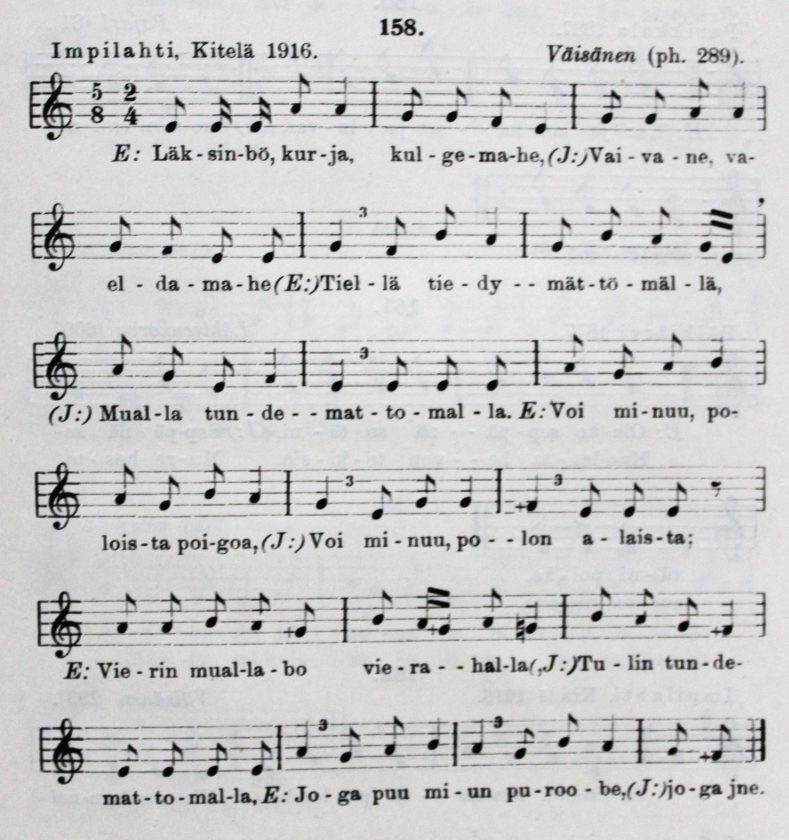
Runosävelmiä II, Karjalan runosävelmät, nro 158, s. 63.
I tried to interpret the rhythm from the sheet music until I realised that Väisänen had recorded Kyyrönen’s song on a wax cylinder. I ordered the recording from the Finnish Literature Society and according to their archives it was made in Helsinki in 1915 (SKS KRA FON 1915:66d). The recording is a perfect example of how musical notation does not bend to interpret the essence of this kind of music – even though Väisänen has made an excellent effort to transfer the fine elements of rhythm to the sheet music. This example also shows how someone who is used to notation (in this case, me) can easily become its slave: although I had played and practised the song along with Matrona Kyyrönen’s singing, on this recording I still slavishly play, for example, the opening rhythm as a dactyl according to the sheet music, when in reality Kyyrönen sings it more syncopated (in the Karelian word lähimbö). The name of the song is taken from the lyrics of the song (Joga puu minuu puroobe = Every tree is biting me):
Lähimbö kurja kulgemahe,
vaivane vajeltamahe,
tiellä tietämättömällä,
mualla tuntemattomalla.
Voi minuu poloista poigoa,
segän(?) on polonalaista.
Vierin muallabo vierahalla,
tulin tuntemattomalla.
Joga puu minuu puroobe,
joga [—]..
After the song, I play on the two 5-string kanteles. On the bronze-stringed kantele I use the double harmonic technique developed by Martti Pokela (1924–2007), in which both the pitch of the open string and the partial tone are heard at the same time. At the end, the 13-string kantele with a Phrygian scale takes us back to Matrona Kyyrönen.
The scale of the 13-string kantele:

The scale of the 5-string kantele:

The scale of the 5-string kantele:

9. Kantervo kalan evästä, feat. Oskari Lehtonen.
In this song, the 12-string hollow kantele from Suistamo and the 15-string kantele are used. Unlike the other songs, this one was already recorded in the spring of 2023 and as a single take. After my own recording, Oskari Lehtonen improvised the percussion. The song was released as a YouTube video in the summer of 2023.
The scale of the 12-string kantele:

The scale of the 15-string kantele:

10. Soitimbo.
The song is played on the 14-string Korpiselkä kantele and the 13-string kantele with bronze strings introduced earlier. According to the original plan, the closing track of the album would have been number 9, but during the editing phase I felt that something was missing. So I made Soitimbo, which became like the final words and signature. When I made my first solo album IRO in 1995, the music was a continuum, whose end I left open. I wanted to bring out the aesthetics of the music. Like, for example, Heikki Laitinen has described the idea of the essence of Karelian kantele improvisation, where the music simply exists without beginning or end. I recorded this song one night and now it was time for me to make a conclusion. I thank and bow.
The scale of the 14-string kantele:

The scale of the 13-string kantele:


